Temple University

Temple University

| The Temple College of Philadelphia (1888) | |
| Motto | Perseverantia Vincit(Latin) |
| Perseverance Conquers | |
| Type | Public (formerly private)State-relatedMulti-campusInternational |
| Established | 1884 |
| APLUCUMU | |
| Endowment | $642.3 million[1] |
| President | Richard M. Englert, EdD[2] |
| Provost | Joanne A. Epps, Esq.[3] |
| 1,554 part time; 2,296 full time (Fall 2018)[4] | |
| 4,528 (Fall 2018)[4] | |
| Students | 40,031 (Fall 2018)[4] |
| Undergraduates | 29,672 (Fall 2018))[4] |
| Postgraduates | 10,359 (Fall 2018)[4] |
| Location | |
| Campus | Urban(Main campus)115 acres (46.5 ha) |
| Colors | Cherry, White[5] |
| Athletics | NCAA Division IFBS–The AmericanPhiladelphia Big 5 |
| Nickname | Owls |
| Mascot | Hooter T. Owl Stella (Live Mascot) |
| Website | |
| University rankings | |
| National | |
| ARWU[98] | 95–116 |
| Forbes[99] | 299 |
| Times/WSJ[100] | 185 |
| U.S. News & World Report[101] | 104 |
| Washington Monthly[102] | 132 |
| Global | |
| ARWU[98] | 301–400 |
| QS[104] | 651–700 |
| Times[105] | 301–350 |
| U.S. News & World Report[106] | 347 |
Temple University (Temple or TU) is a public research university in Philadelphia, Pennsylvania. It was founded in 1884 by the Baptist minister Russell Conwell. In 1882, Conwell came to Pennsylvania to lead the Grace Baptist Church while he began tutoring working-class citizens late at night to accommodate their work schedules. These students, later dubbed "night owls", were taught in the basement of Conwell's Baptist Temple, hence the origin of the university's name and mascot. By 1907, the institution revised its institutional status and was incorporated as a university.[6][7]
As of 2018, about 40,000 undergraduate, graduate, and professional students were enrolled in more than 500 academic degree programs offered at sites across the globe, including eight campuses across Pennsylvania, Rome, and Tokyo.[4] Temple is among the world's largest providers of professional education (law, medicine, podiatry, pharmacy, dentistry, and architecture), preparing the largest body of professional practitioners in Pennsylvania.[8][9]
Temple's sports teams, the Owls, compete in NCAA Division I sporting events.
| The Temple College of Philadelphia (1888) | |
| Motto | Perseverantia Vincit(Latin) |
| Perseverance Conquers | |
| Type | Public (formerly private)State-relatedMulti-campusInternational |
| Established | 1884 |
| APLUCUMU | |
| Endowment | $642.3 million[1] |
| President | Richard M. Englert, EdD[2] |
| Provost | Joanne A. Epps, Esq.[3] |
| 1,554 part time; 2,296 full time (Fall 2018)[4] | |
| 4,528 (Fall 2018)[4] | |
| Students | 40,031 (Fall 2018)[4] |
| Undergraduates | 29,672 (Fall 2018))[4] |
| Postgraduates | 10,359 (Fall 2018)[4] |
| Location | |
| Campus | Urban(Main campus)115 acres (46.5 ha) |
| Colors | Cherry, White[5] |
| Athletics | NCAA Division IFBS–The AmericanPhiladelphia Big 5 |
| Nickname | Owls |
| Mascot | Hooter T. Owl Stella (Live Mascot) |
| Website | |
| University rankings | |
| National | |
| ARWU[98] | 95–116 |
| Forbes[99] | 299 |
| Times/WSJ[100] | 185 |
| U.S. News & World Report[101] | 104 |
| Washington Monthly[102] | 132 |
| Global | |
| ARWU[98] | 301–400 |
| QS[104] | 651–700 |
| Times[105] | 301–350 |
| U.S. News & World Report[106] | 347 |
History
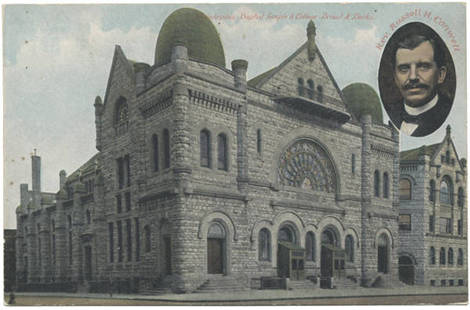
Postcard depicting the original Baptist Temple and Russell Conwell

President Harry S. Truman visits Temple University
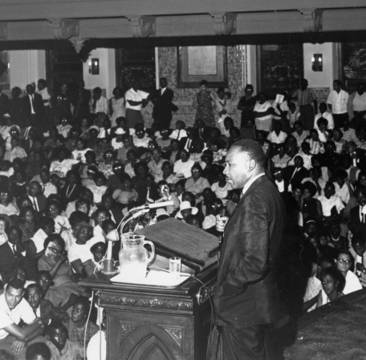
Martin Luther King, Jr. lecturing at Temple University
Temple University was founded in 1884 by Russell Conwell, a Yale-educated Boston lawyer, orator, and ordained Baptist minister, who had served in the Union Army during the American Civil War. Conwell came to Pennsylvania in 1882 to lead the Grace Baptist Church while he began tutoring working class citizens late at night to accommodate their work schedules. These students, later dubbed "night owls," were taught in the basement of Conwell's Baptist Temple, hence the origin of the university's name and mascot. The Grace Baptist Church quickly grew popular within the North Philadelphia area. A temporary board of trustees was created to handle the rapidly growing formalities associated with the church's programs. When the board conducted its first meeting they named Russell H. Conwell president of "The Temple College." Within the following months, Grace Baptist Church appointed a new board of trustees, printed official admissions files, and issued stock to raise funds for new teaching facilities. Regardless of whether they had the resources to support the school, Conwell's desire was “to give education to those who were unable to get it through the usual channels”.[10]
Philadelphia granted a charter in 1888 to establish “The Temple College of Philadelphia”, but the city refused to grant authority to award academic degrees.
By 1888, the enrollment of the college was nearly 600.
It was in 1907 that Temple College revised its institutional status and incorporated as a university.
Legal recognition as a university enhanced Temple in noticeable ways including its reputation, professional and graduate programs, overall enrollment, and financial support.[10]
Over time, Temple expanded: Samaritan Hospital was founded, a Medical School was added, and Temple merged with the Philadelphia Dental College.[10] After the merger, Temple officially reincorporated as Temple University on December 12, 1907.
On April 2, 1965, Lester B. Pearson, Prime Minister of Canada and recipient of the Nobel peace prize, was awarded the Temple University World Peace Prize. During his acceptance speech, Pearson criticized American bombing of Vietnam:
There are many factors which I am not in a position to weigh.
But there does appear to be at least a possibility that a suspension of such air strikes against North Vietnam, at the right time, might provide the Hanoi [communist] authorities with an opportunity, if they wish to take it, to inject some flexibility into their policy without appearing to do so as the direct result of military pressure.[11]
The speech infuriated President Lyndon B. Johnson who, the next day at Camp David, took Pearson out onto the terrace and began "laying into [Pearson] in no uncertain fashion". Pearson later apologized for the speech.[11]
Since 1965, Temple has been a Pennsylvania state-related university, meaning the university receives state funds, subject to state appropriations, but is independently operated.[13]
Campus
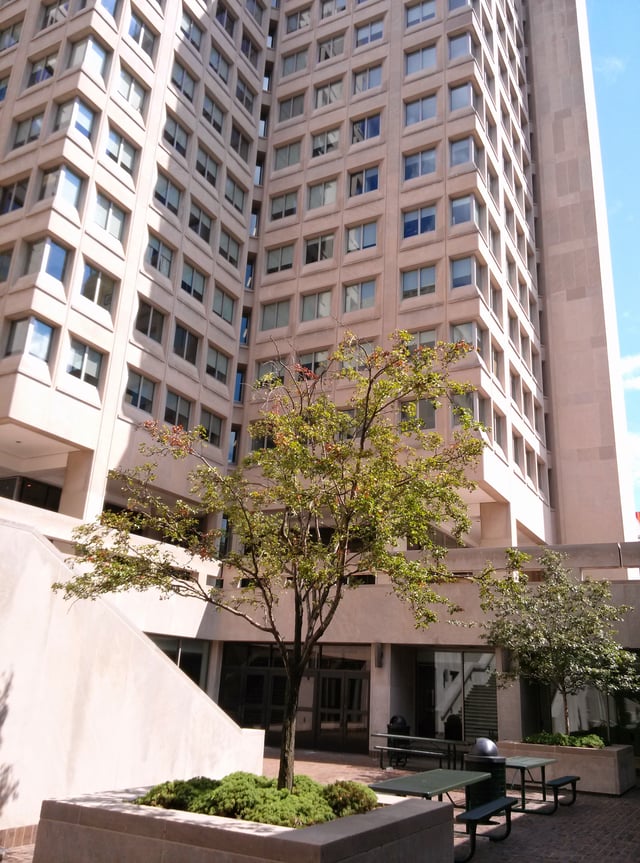
Anderson Hall
Temple University has six campuses and sites across Pennsylvania, plus international campuses in Rome and Tokyo.[14]
Pennsylvania campuses
Main campus
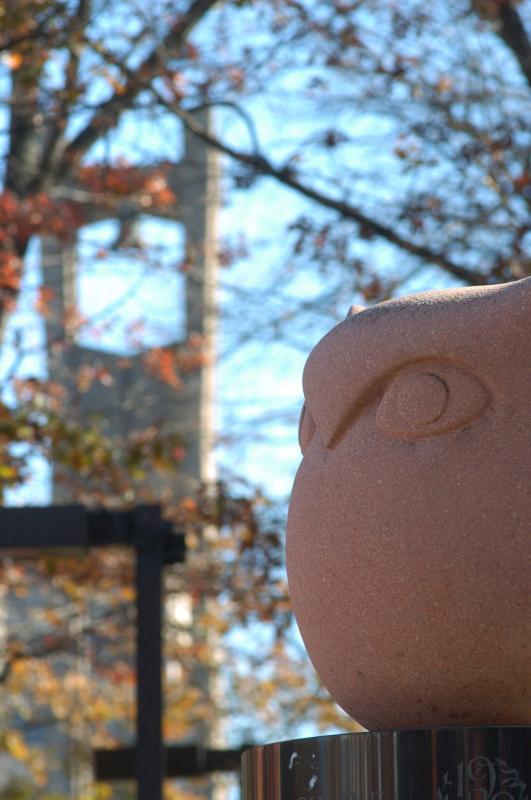
Red Owl, by Beniamino Bufano, at Temple University's "Alumni Circle"
The Founder's Garden near Liacouras Walk, is the burial place of Russell Conwell, founder and 38-year president of Temple.[17] A former Yale student, Civil War captain, Boston lawyer, and Philadelphia minister, Conwell used the income from his famous “Acres of Diamonds” speech to fund Temple[10] as a place where working-class Philadelphians might receive higher education. It has been estimated that Conwell, who died at 82, helped more than 90,000 men and women[19] pursue higher education. A bust of Conwell marks his grave. Another green area on campus is the Johnny Ring Garden. It is located near the faculty staff dining 'Diamond Club', and celebrates Conwell and Johnny Ring.
The Bell Tower sits at 110 ft.
tall in the center of the Main Campus between Paley Library and Beury Hall.
The surrounding plaza and grassy area, the largest "green space" on the urban campus, are commonly called "the beach".
The area is a meeting place and hangout location for students and their protests, promotions, speeches, political campaigning, and charity drives.
It also hosts various official events such as Spring Fling.[20]
Other campuses
Health Sciences Campus (HSC) is in North Philadelphia, spanning Broad Street from Allegheny Avenue to Venango street. The campus is home to Temple University Hospital, a teaching hospital; Lewis Katz School of Medicine; School of Pharmacy; Maurice H. Kornberg School of Dentistry; and College of Public Health.
Podiatric Medicine Campus is at the corner of 8th and Race street. The Foot and Ankle Institute, TUSPM Shoe Museum and Temple University School of Podiatric Medicine can be found at this location.[21]
Center City Campus is across the street from Philadelphia City Hall. TUCC offers undergraduate and graduate courses and degree programs, as well as certificate and training programs, with classes offered primarily during the evenings and on weekends.
Ambler Campus, originally a junior college, hosts 325 faculty and 4,600 students, offering bachelor's and master's degree programs on a site with a 187-acre (757,000 m2) arboretum, 13 miles (21 km) from Temple's main campus.
Harrisburg Campus, in Harrisburg, Pennsylvania, offers a variety of graduate degree programs, certificate programs, and professional development opportunities. The school has specialties in social work, public health, education, community and regional planning, and play therapy. The campus offers an evening and weekend course schedule designed in particular for working adults.[22]
Foreign campuses
Temple University Japan
Temple University Japan (TUJ) is a branch campus in Setagaya-ku, Tokyo, Japan. Temple University Japan was the oldest and largest campus of any foreign university in Japan, before its move from Minato-ku.[23] TUJ is a home for around 4,800 learners with students from approximately 60 countries around the world, including Japan, the United States, East and Southeast Asia, Russia, the Middle East, Africa, Latin America, and Europe.[23] Non-degree enrollment is about 3,426 including Academic English and Continuing Education programs, and degree program enrollment is 1,389 (2016).[24]
In addition to its core undergraduate program, TUJ offers graduate programs in law, business, and education; an English-language preparation program; continuing education courses; and corporate education classes.[25] It also offers semester- and year-long study abroad programs for U.S. undergraduates and law students (the latter is the first American Bar Association-accredited study abroad program in Asia).
After extended negotiations involving the U.S. and Japanese governments, Temple University Japan became the first recognized foreign university campus in Japan.[26] As a result, its credits and degrees are recognized as being equivalent to those of Japanese universities and it can sponsor visas for international students.
Students are also given Japanese student identification cards and can obtain student discounts on train passes, mobile phone contracts, and other items.
Temple University Rome
The Temple Rome campus is in Rome, in the Temple's Villa Caproni, just north of Piazza del Popolo. The Villa Caproni offers living accommodations, shops and restaurants, and facilities for students. Its facilities include a 15,000-volume library – one of the largest English-language libraries in Rome – a computing center, academic classrooms, extensive art and architecture studios, an art gallery and student lounges. While studying in Rome, most students can also reside in the Residencia Candia, which is in the vicinity of the Vatican.
Residence halls in Philadelphia
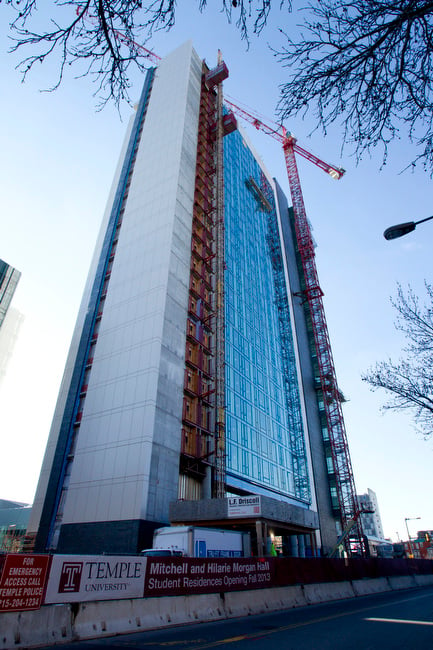
The Mitchell and Hilarie Morgan Hall in Philadelphia (under construction in 2013)
Students can live in several on-campus housing units: Morgan Hall, Johnson and Hardwick Residence Halls, James S. White Residence Hall, 1940 Residence Hall, 1300 Residence Hall, and Temple Towers Residence Hall.[27]
- Johnson and Hardwick Halls
The Johnson and Hardwick Residence Halls are 11-floor high-rise facilities that are used as the traditional residence halls on the Main Campus.
The buildings house around 1,000 Temple students every year.
The Louis J. Esposito Dining Center is on the ground level of the Johnson and Hardwick Halls near the north end of Main Campus.
The cafeteria is commonly referred to as J&H after the residence halls. The Esposito Dining Center is one of three major cafeterias on campus. Johnson & Hardwick is home to three Living Learning Communities including Performing and Cinematic Arts, Major Exploration, and School of Media and Communication.[28] Since 2006, the rooms and bathrooms in Johnson and Hardwick Residential Halls have been renovated. Restorations in 2010 included the renovation of a lobby with new entry points, security stations, office space, and lounge space. Most recently in the summer of 2017, both interior and exterior renovations to the residence halls were completed.[29]
- James S. White Hall
White Hall is a four-story complex that opened in the fall of 1993 and houses 558 newly admitted first-year students in two-person and four-person suites with private baths.
It also includes two open-air courtyards, areas for TV viewing, exercising, and studying.[30] White Hall is also home to three Living Learning Communities: Innovate and Create, Leadership, and Residential Organization for Community Service (ROCS).[30]
- 1940 Residence Hall
470 first- and second-year students live in 1940 Residence Hall, opened in the fall of 1999.
Residents live in two-person and four-person suites with private baths.
Residents of “1940” enjoy game-rooms, a TV lounge, a multipurpose room for programming, and many study and social areas.[31] In addition, 1940 hosts several Living Learning Communities: Architecture & Environmental Design, College of Engineering, Healthy Lifestyles, School of Sports, Tourism and Hospitality Management, Sustainability, and Tyler School of Art.[31]
- 1300 Residence Hall
Opened in the fall of 2001, 1300 North and South accommodates up to 1044 newly admitted, returning, and transfer Main Campus students in suites on the first three floors and in apartments on the top two floors of the complex.
1300 is also home to the Honor's Program and the Leadership and Service Living Learning Communities.
Residents of 1300 enjoy a TV lounge, a game room, and study and social areas.
1300 also contains several classrooms for Honors students.[33]
- Morgan Hall[s]
A mixed-use residential, retail, and dining facility, the Mitchell and Hilarie Morgan Residence Hall and Dining Complex, opened in July 2013.
On the corner of Broad Street and Cecil B. Moore Avenue, steps from the Broad Street Subway Line, the site contains three buildings surrounding a large terrace, and is designed to house nearly 1,300 students.
The tallest of the buildings is the 27-floor Morgan Hall North, which is situated on the North end of the site.[34] It contains 24 floors of residential space for both first-year experience students (transfers and freshmen) as well as returning students (sophomores, juniors, and seniors), a top floor event space, and retail space on the ground level.
Connected to Morgan Hall North is the Dining Hall building, which runs along Broad Street and provides students with 5 dining options.
Morgan Hall South is ten floors tall and houses first-year students, or freshmen.
Both Morgan North and South are notable in that unlike other suite-style residence halls at Temple University, the rooms also include small kitchenettes with a cooktop, full fridge, and microwave.
The suites include two bedrooms that share a common living area and private bathrooms.
Both residence halls feature floor-to-ceiling windows covering the entire side of the building to provide views of the campus, Center City, and allow for extensive natural light to enter into all interior spaces of the building.[34]
- Temple Towers
This six-story complex houses approximately 658 second-year and transfer students and consists of two towers, East and West.
This residence hall features three-, six-, and seven-person bedroom apartments, all with private bathrooms and fully equipped kitchens.
Bedroom furniture, desks and chairs, and living room furniture are provided.
Residents at Temple Towers have the option of choosing to be on the meal plan.
Temple Towers is also home to the Global Living Learning Communities program.[36]
Temple Towers offers a game room, social lounges (with a fireplace), study lounges, a TV lounge, a bike storage space, and computer stations with printing.
- Graduate housing
Podiatry Housing is a seven-story apartment building at 8th and Cherry Street in Center City Philadelphia.
This complex is walking distance from a number of the city's finest shops and historical attractions.[37]
- Peabody Hall (Demolished)
The Peabody Residence Hall was another traditionally styled dormitory on the Main Campus.
In 2006, the building celebrated its 50th anniversary.
Peabody Hall was originally designed as a women's residence hall with a campus cafeteria in the basement.
The residence hall building structure had undergone many renovations to better serve modern students including a study/conference room lounge, game room, computer lab, kitchen, new windows, and air conditioning.
The Gertrude Peabody Residence Hall was also known to have been built on land that once occupied one of Russell Conwell's, Temple University's founder, original homes.[38]
Announced before winter break in the 2017-2018 academic year, the University demolished Peabody Hall.
A new, multi-purpose building is being explored to fill the location where Peabody stood.[39]
Campus police
The Temple University Police department is the largest university police force in the United States, with 130 campus police officers, including supervisors and detectives.[40][41] All are Pennsylvania-certified law enforcement officers; each receives state-mandated police recruit training at an accredited state police academy.[42]
The police keep watch on campus with the help of more than 600 security cameras and more than a thousand 1000-watt metal halide lamps mounted on campus roofs to mimic daylight.[43]
Temple has two mass notification systems for emergencies, TUalert and TUsiren.[44]
Sustainability
The Ambler campus’ "Ambler College", which is home to the Community and Regional Planning, Landscape Architecture, and Horticulture Departments, changed its name in 2009 to the School of Environmental Design.
The campus is also home to the Center for Sustainable Communities, a Sustainability-based research center.[47]
Since 2008, the university has enacted policies that include purchasing from green vendors and conserving water and energy across campus;[48] offered 46 undergraduate courses, 22 graduate courses and 12 General Education courses focusing on the environment and sustainability; set in place programs to administer grants and offer incentives for any research related to the environment or sustainability;[49] and offered programs to help create a green culture, both at Temple and beyond.[50][51]
Campus development
In 2009, Temple announced Temple 20/20, a framework to guide development at its main campus.
Among its goals, it will make Broad Street the center point of the university and include a new library for students and the community; a large new green space; a new science building and a high rise residence hall.
The university in 2014 adopted a new campus plan, Visualize Temple, with signature projects including a new library and quad in the heart of campus.[52] A companion project, Verdant Temple, was announced in 2015 as a university strategy for updating and beautifying the school's open spaces, walkways and landscaping.[53]
Projects
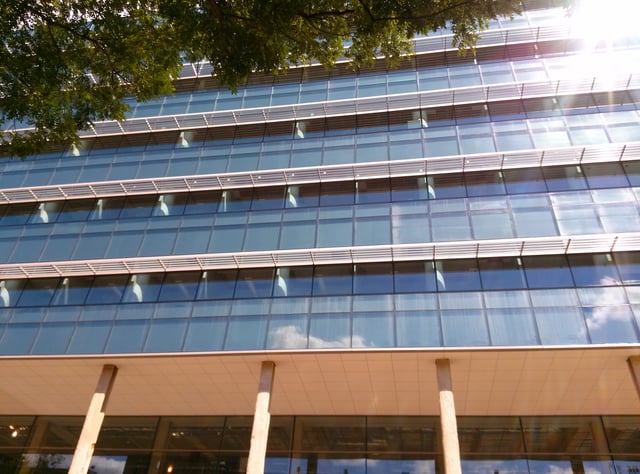
Science and Education Research Center
The Architecture building opened January 2012.
The design incorporates an innovative glass curtain wall exterior “skin” that allows daylight to flood interior studios and classrooms while also providing dynamic views of the surrounding urban environment.
The open plan of the structure enables collaboration within the design studios, supporting the experiential learning environment that is unique to design programs.[54]
Mitchell and Hilarie Morgan Hall, a 27-story tower and ten-story mid-rise, opened September 2013.
Mixed-use residence life facility contains student residences with 1,275 beds, laundry facilities, shared lobby areas, all-glass, two-story lounges with views of Center City; dining facilities; meeting rooms and event spaces; a major open landscape area; restaurant; coffee shop.[55]
Pearson-McGonigle addition and renovations were completed during the summer of 2012.
A major addition to and renovation of two existing athletic facilities to create one expanded facility.
There are new and renovated training and support spaces for recreation services and NCAA Olympic Sports; Division One practice and training facilities for men's and women's basketball; five full basketball courts for students; rock climbing; juice bar; and new academic and advising space.[56]
Science and Education Research Center was complete in spring of 2014.
This new seven-story facility will support specialized research and instruction in technology-enhanced lecture halls, flexible classrooms, and research labs that are designed to enable collaboration and hands-on exploration in science and technology.
New types of highly flexible wet and dry lab space for physics, materials science, chem-bio, computational science, and computer information sciences will enable new kinds of research to be conducted, and will provide research opportunities for undergraduates.
The distinctive building exterior will be made of limestone panels and an energy-efficient glass curtain wall which uses daylight harvesting and exterior horizontal sunshades to reduce energy costs.
The project will attain LEED Silver certification, and possibly LEED Gold certification due to the innovative design of the facility and the site.[57]
On Aug. 25, 2019, the university unveiled Charles Library, a four-story tall study facility.
The design of the building was created by international architectural design office, Snøhetta.[60]
On Jan. 18, 2018, Temple President Richard M. Engert announced that the university would take steps to advance its proposal of building a multipurpose facility, including retail space and a football stadium, on campus—including filing a project submission for review by the Philadelphia City Planning Commission.[61]
Other recent campus projects including a revamped Founder's Garden and the debut of O’Conner Plaza, which included the addition of a water wall and an iconic bronze statue of an owl.[17]
Academics

Philadelphia skyline, looking south from Temple University's Morgan Hall on Broad Street
Temple University is designated as an "R1" Research University (Highest Research Activity) by the Carnegie Foundation for the Advancement of Teaching,[62] and offers more than 500 degree programs at 15 schools and colleges and five professional schools, including programs in art, business, communications, education, engineering, liberal arts, music, science, and the health professions.
Schools and colleges
Boyer College of Music and Dance
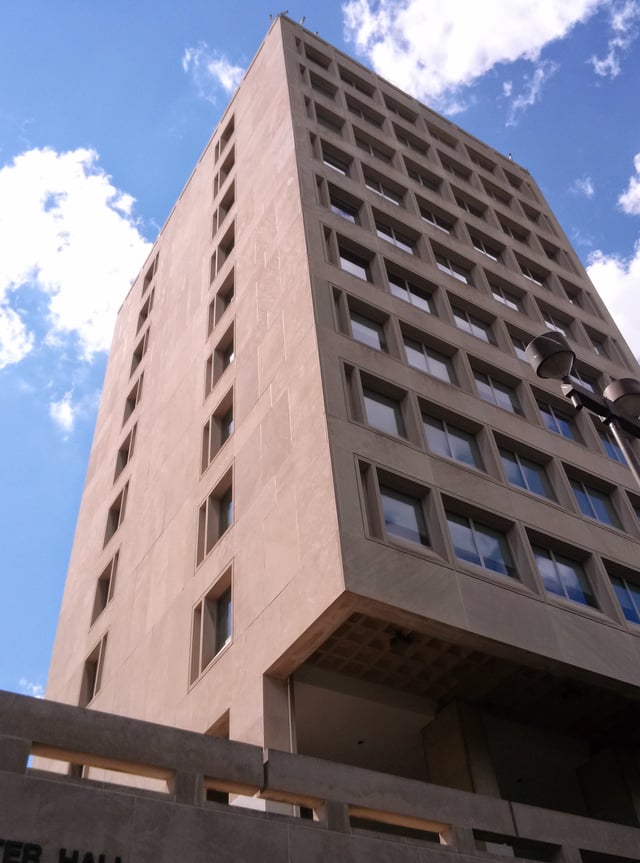
Gladfelter Hall at the College of Liberal Arts
The Boyer College of Music and Dance is part of the Center for the Performing and Cinematic Arts at Temple University in Philadelphia, Pennsylvania, in close proximity to the city's historic cultural institutions, including the Kimmel Center for the Performing Arts, The Philadelphia Orchestra, Opera Philadelphia, Pennsylvania Ballet, Philadanco and the Philadelphia Museum of Art.[63]
College of Engineering
The College of Engineering at Temple University includes five departments: Bioengineering, Civil & Environmental Engineering, Electrical & Computer Engineering, Mechanical Engineering, and Center for Engineering, Management & Technology.
The college offers eight undergraduate programs (B.S.) and seven graduate programs (M.S., Ph.D.).[64]
College of Liberal Arts
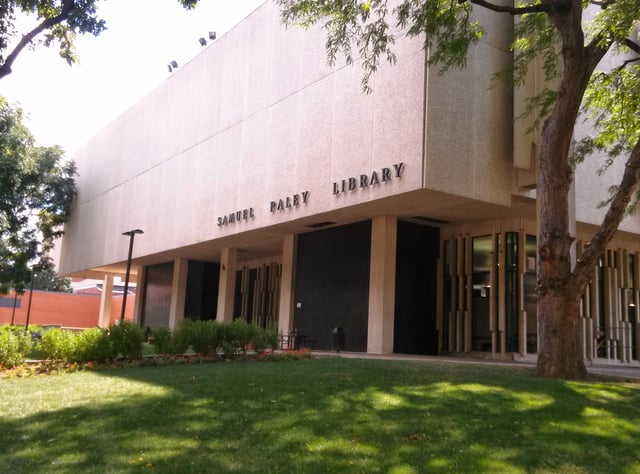
Samuel L. Paley Library, Temple University
The College of Liberal Arts at Temple University includes 28 academic departments, offering 35 undergraduate majors and 36 minors.
The College of Liberal Arts is housed in Anderson and Gladfelter Halls.
The Criminal Justice department is one of the leading criminal justice programs in the United States.[65] The college offers 15 master's degrees and 13 doctoral programs.[66]
College of Public Health
Temple University's College of Public Health includes the departments of Communication Sciences and Disorders, Epidemiology and Biostatistics, Health and Rehabilitation Sciences, Health Services Administration and Policy, Kinesiology, Nursing, Social and Behavioral Sciences and the School of Social Work.
It is one of the largest colleges of public health in the United States.
The College of Public Health offers bachelor's, master's and doctoral degrees as well as certificate programs.
College of Science and Technology
Temple University's College of Science and Technology houses the departments of Biology, Chemistry, Computer & Information Sciences, Earth & Environmental Science, Mathematics, and Physics.
It is one of the largest schools or colleges of its kind in the Philadelphia region with more than 230 faculty and 4,000 undergraduate students.[67]
The College of Science and Technology offers bachelor's, master's, and doctoral degrees in all six departments as well as science with teaching bachelor's degrees through the TUteach program.
CST's advanced Science Education and Research Center, which opened in 2014, is 247,000 square feet research center, home to 7 research center and institutes.
The Center has 52 research labs and 16 teaching rooms, and cost $137 million.[68]
Fox School of Business
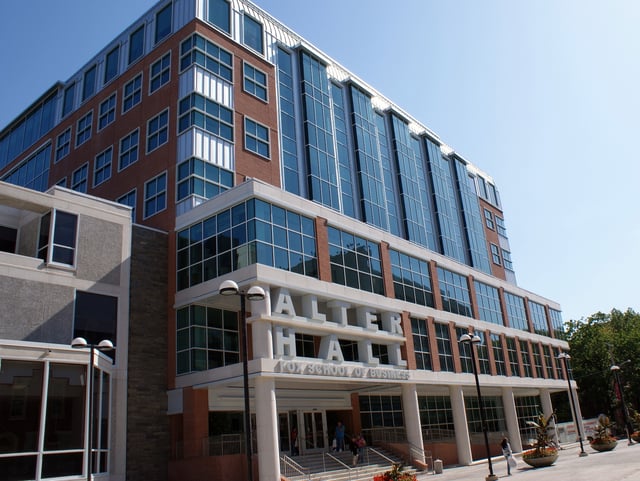
Alter Hall at Fox School of Business
The Fox School offers 15 undergraduate majors, 19 minors,10 professional master's programs, and two PhD programs, and the school has a variety of international partnerships.[69]
It ranked in the top 30 in the nation in the 2017 Times Higher Ed World University Rankings and top 80 in the world for undergraduate studies.[70]
Klein College of Media and Communication
Klein College of Media and Communication (formerly, the School of Media and Communication) is one of the largest and most comprehensive schools of media and communication in the country.
The school has about 3,000 undergraduate and graduate students, nearly 20,000+ alumni, and more than 60 full-time faculty members.[71]
Lewis Katz School of Medicine
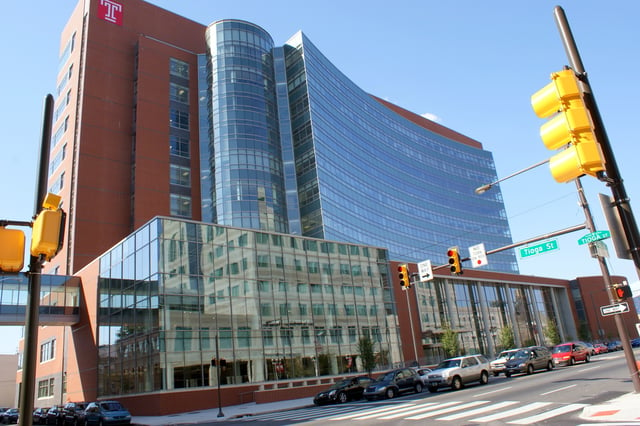
Lewis Katz School of Medicine
In July 2014, Lewis Katz School of Medicine scientists were the first to remove HIV from human cells.[74]
In October 2015, the school of medicine was officially named the Lewis Katz School of Medicine at Temple University in honor of Temple alumnus, former trustee, visionary leader and ardent supporter Lewis Katz.[75]
School of Pharmacy
The Temple University School of Pharmacy (TUSP), on the Health Science Campus of Temple University in Philadelphia, is one of 6 schools of pharmacy in Pennsylvania conferring the doctor of pharmacy (Pharm.D.) degree. It also confers the Ph.D. (doctor of philosophy) and M.S. (master of science) degrees in pharmaceutical sciences.
Tyler School of Art and Architecture
The Tyler School of Art and Architecture was founded in Elkins Park, Pennsylvania, in the 1930s, when Stella Elkins Tyler donated her estate to Temple University. Tyler moved to a state-of-the-art facility at Temple's Main Campus in Philadelphia in 2009.[76] In 2019, more than 20 years after Temple's Architecture programs became part of Tyler, the school expanded its name, becoming the Tyler School of Art and Architecture.[77]
Tyler was ranked number 15 in fine art schools in the United States by U.S. News & World Report in 2016.[78]
School of Theater, Film and Media Arts
TFMA offers BA and BFA programs in 13 concentrations in disciplines from musical theater to cinematography, screenwriting to theater design.[80][81] Graduate programs include MFA programs in Film and Media Arts, Musical Theater Collaboration, Acting, Design, Directing and Playwriting, as well as MA programs in mediaXarts and Musical Theater Studies and a PhD in Documentary Arts and Visual Research.[82][83]
Beasley School of Law
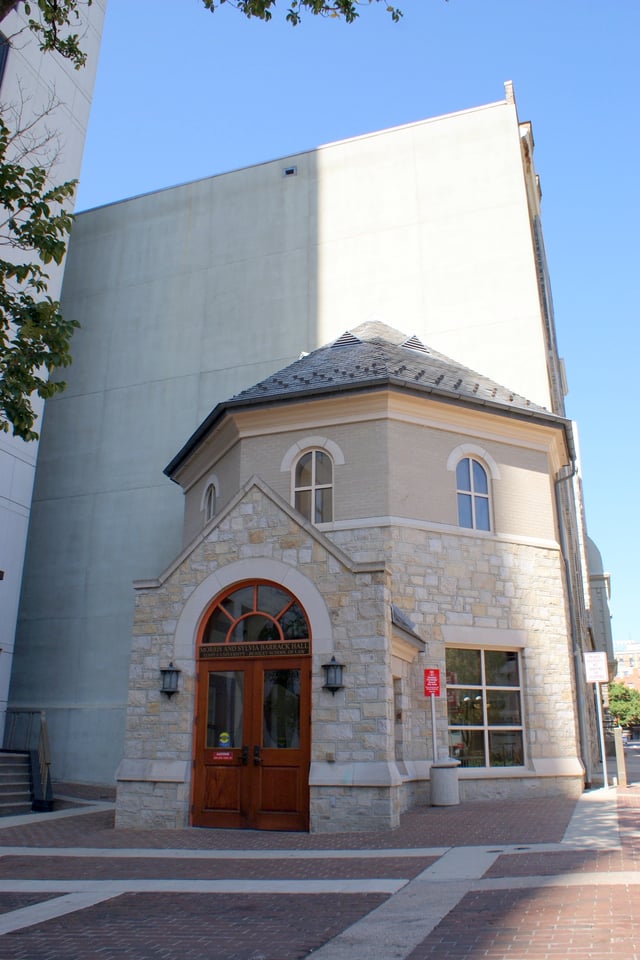
Barrack Hall at Beasley School of Law
The Beasley School of Law was founded in 1895.[84] With a reported enrollment of more than 860 students in Fall 2017, the school trains students with programs focused on trial advocacy, transnational law, and taxation, among others.[84][85] The school offers full- and part-time programs, offering evening classes for working students.[86] As of 2018, U.S. News & World Report ranked the school the 47th best law school in the United States.[87]
College of Education
The College of Education has more than 2,140 students (undergraduate, graduate programs, and non-matriculating students).[84] Founded in 1919, the college is organized into three departments: Teaching & Learning, Policy, Organizational & Leadership studies, and Psychological Studies in Education.[88] The college has a longstanding relationship with the School District of Philadelphia, helping to teach and prepare future educators for the city.[88]
School of Social Work
School of Podiatric Medicine
Kornberg School of Dentistry
With nearly 700 students, the Kornberg School of Dentistry has been educating dental students since 1863—making it the second oldest dental school in continuous existence in the United States.[91][92][84] The school's clinic offers services including routine dental care and prevention to children's dentistry, orthodontics, emergency care, and implants.[92]
School of Sport, Tourism, and Hospitality Management
Foreign study
Temple offers study-abroad opportunities at its campuses in Rome and Tokyo, and semester and summer programs in London, Rome, Japan, Dublin, Germany, France, China, South Africa, Spain, Ecuador, and Australia.[95] Temple University has a global internship program, offering internships in Spain, Costa Rica, Australia, India, Chile, China, Singapore, and various U.S. cities[96]
Technology
In January 2006, the university opened the TECH Center, a 75,000 sq ft (7,000 m2) technology facility.[97]
Rankings
In U.S. News & World Report's 2020 rankings, Temple is tied for 44th among U.S. public universities, tied for 104th among all national universities and ranked tied for 347th globally.[107] Temple undergraduate college is among the top colleges profiled in The Princeton Review's The Best 382 colleges (2018).[108] Temple's Arts and Humanities faculty, Social Science and Management faculty, Life Science and Medicine faculty are ranked 182nd, 339th, 350th respectively in the world in 2014 by QS World University Rankings.[109][110][111] Temple's Social Science faculty is also ranked 51-75 in the world in 2016 by ARWU.[112]
In 2017, Temple received $268.4 million in research funding, ranking it 85th out of 901 institutions in the NSF's Higher Education Research and Development Survey.[113]
Student life
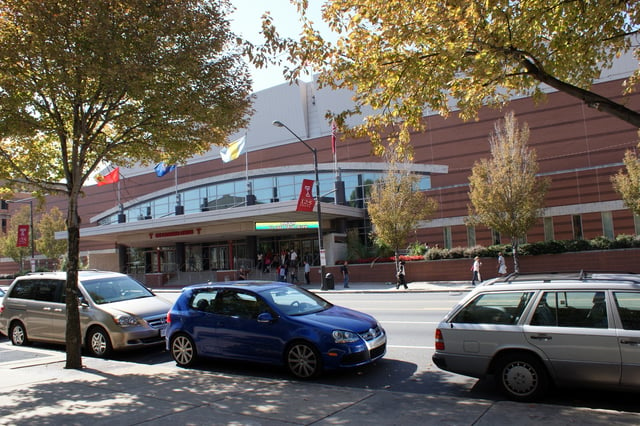
Liacouras Center
As of 2018, about 11,000 students live on or around Temple's main campus.
University officials have tried various things, including building facilities, to encourage students, faculty, and staff to live and work nearby.[84]
Recreational facilities on and around main campus include the Howard Gittis Student Center, which has a movie theater, food court, underground multi-purpose room, game room, computer lounge, and meeting and office space for student groups and organizations.
Exercise facilities include the Independence Blue Cross Student Recreation Center (commonly referred to as IBC), which provides 59,000 square feet (5,500 m2) of fitness facilities; the Student Pavilion, a 4-court field house for volleyball, basketball, badminton, floor hockey, indoor soccer, tennis, golf, and more; and Pearson/McGonigle, TU Fitness, and the Geasey Field Complex.
The Recreation Center is part of the Liacouras Center, which also includes the home court of the Temple basketball team and various entertainment venues.
In 2017, the Aramark Student Training and Recreation Complex (commonly referred to as STAR) was built, which includes a new climbing wall and the weight room.
There is also academic classrooms for the College of Public Health, administrative offices, a Jamba Juice and a 75-yard turf field.
Traditions
- Cherry and White
Cherry and White are the official school colors of Temple University.
Temple was the first school in the nation to officially use cherry as one of its colors, and the only other current school uses the cherry and white combination: Rensselaer Polytechnic Institute in Troy, New York. The only other large university that uses cherry is the University of New Mexico.[115] Cherry is a common motif at Temple, from the Cherry Crusade fan club to the Cherry and White Directory. In 2008, Temple standardized the cherry color to be Pantone Matching System (PMS) 201.[116]
- The Temple "T"
The university's symbol, the Temple "T", was designed by students in a graphic arts and design class in the Tyler School of Art and Architecture in 1983. The “T” represents strength and positive character, with the open ends showing the free exchange of ideas that is the hallmark of a Temple education.[117] The Temple T is referenced in the school's cheer, T For Temple U.
- T For Temple U
T For Temple U is a cheer performed at many sporting events, pep rallies, and school celebrations.
The song was written in the 1980s by a member of the Temple University Diamond Marching Band.
T For Temple U is accompanied by arm motions that create the shapes of the letters T and U. Temple's official fight song is "Fight, Temple, Fight!"
- The Owl
The owl is the symbol and mascot for Temple University and has been since its founding in the 1880s, making it the first school in the United States to adopt the owl as its symbol.[118] The nocturnal hunter symbolized Temple's early mission: to be a night school for ambitious young people of limited means.
Russell Conwell encouraged these students, saying, "The owl of the night makes the eagle of the day."
In 1977, Temple introduced "Victor T. Owl," a costumed mascot, which was then renamed Hooter in 1984, and has remained Temple's mascot at sports games and events since.[119] Stella, Temple's live owl mascot, was born in 2010 in Washington State.[120] She was raised and trained by Master Level Falconer, Clarence C. Lupo. She arrived in Pennsylvania in 2011 and lives in the Elmwood Park Zoo in Norristown, Pennsylvania. Stella is one of two live owl mascots in Division 1 athletics, the other being Florida Atlantic University's Hera.[121]
Fraternities and sororities
Temple has hosted fraternities and sororities for more than 100 years.
As of 2018, 28 organizations are part of the Temple University Greek Association, while the Greek population has more than doubled in recent years to more than 1,600 undergraduates.[122]
- Inter-Fraternity Council
Alpha Kappa Lambda (ΑΚΛ)
Alpha Tau Omega (ΑΤΩ)
Kappa Delta Rho (ΚΔΡ)
Kappa Sigma (ΚΣ)
Pi Kappa Phi (ΠΚΦ)
Pi Lambda Phi (ΠΛΦ)
Sigma Alpha Mu (ΣΑΜ)
- Multicultural Greek Council
Alpha Sigma Rho (ΑΣΡ)
Delta Chi Psi (ΔΧΨ)
Delta Kappa Delta (ΔΚΔ)
Delta Phi Omega (ΔΦΩ)
Iota Nu Delta (ΙΝΔ)
Kappa Phi Gamma (ΚΦΓ)
Lambda Theta Alpha (ΛΘΑ)
Lambda Theta Phi (ΛΘΦ)
Sigma Beta Rho (ΣΒΡ)
Theta Tau Alpha (Θτ)
Alpha Phi Alpha (ΑΦΑ)
Delta Sigma Theta (ΔΣΘ)
Kappa Alpha Psi (ΚΑΨ)
Omega Psi Phi (ΩΨΦ)
Phi Beta Sigma (ΦΒΣ)
Sigma Gamma Rho (ΣΓΡ)
- Panhellenic Association
Alpha Epsilon Phi (ΑΕΦ)
Alpha Xi Delta (ΑΞΔ)
Delta Delta Delta (ΔΔΔ)
Delta Phi Epsilon (ΔΦΕ)
Delta Zeta (ΔΖ)
Phi Sigma Sigma (ΦΣΣ)
Student organizations
Temple University has more than 300 student organizations for a variety of interests academic, professional, political and advocacy, service, religious, cultural and international, arts, entertainment, recreation and leisure, and media and publishing.[123]
- Temple University Graduate Students' Association
The Temple University Graduate Students' Association (TUGSA), which is affiliated with the American Federation of Teachers and the AFL-CIO, is the only recognized graduate student employee union in Pennsylvania.
Formed in 1997, TUGSA is a union that advocates for graduate students that are employed by the university as teaching or research assistants.[124]
- Main Campus Program Board
The Main Campus Program Board is a student-run organization that plans the premiere events for the Temple student body.
They specialize in large-scale events for the student community on Main Campus, organize trips to locations throughout the region, plan student Homecoming events including the annual Homecoming concert, and host speakers, comedians, and novel events.[125]
- Media
The Temple News is the editorially independent weekly newspaper of Temple University. It prints 5,000 copies to be distributed primarily on Temple's Main Campus every Tuesday. A staff of 25 plus more than 150 writers design, report and edit the 20-page paper. In 2008, the paper's Web site, temple-news.com, received the National Online Pacemaker Award from the Associated Collegiate Press.[126] In 2015, the paper also won the print counterpart, the National Pacemaker Award.[127] In 2009, the paper's staff won eight Keystone Press Awards.[128] Templar, Temple University's annual undergraduate yearbook, was created in 1924.[129] During 2017, the yearbook received a national second-place award from the American Scholastic Press Association.[130] WHIP, an acronym that stands for We Have Infinite Potential, is Temple University's student radio station. It started broadcasting using Carrier Current in the Student Center before moving its studios to the TECH center. WHIP also gets increased visibility in a top-five media market as one of iHeartRadio's top college radio stations. Temple also has TUTV, a digital cable station that broadcasts to Philadelphia. TUTV features programs from Klein College School of Media and Communication, other colleges and schools at Temple, community and professional broadcasting partners.[131]
Athletics
Temple University's sports teams are the Owls: a name born from Temple's early days when it was a night school.
The sports teams all participate in the NCAA's Division I and the American Athletic Conference (The American). The Owls moved after spending the previous 31 years in the Atlantic 10 Conference (A-10). The field hockey and lacrosse teams are affiliate members of the Big East Conference. The Owls are also part of the Philadelphia Big 5, the Philadelphia-area basketball rivalry. Temple University was among the first institutions in the United States to sponsor extracurricular athletic activities for its students when both the football and basketball programs were inaugurated in 1894 under the direction of Coach Charles M. Williams.[132]
Football
Temple's football program dates back to 1894 and currently plays Division I FBS football in the American Athletic Conference.[133]
On December 17, 2012, Matt Rhule [pronounced rule] was named Temple's 26th head football coach. He had most recently served as the assistant offensive line coach with the New York Giants. Rhule was an assistant coach for the Owls for six seasons, ending in 2010-11 when the program went 9–4 and played in the fourth bowl game in school history, the Gildan New Mexico Bowl, where the Owls defeated Wyoming, 37–15 – Temple's first postseason victory since the 1979 Garden State Bowl.[134] In 2015, they posted a school-record-tying 10 wins and 4 losses.[135]
Temple won the 2016 American Athletic Conference Football Championship Game to secure its first conference championship since 1967. On December 13, 2016, Geoff Collins was named Temple's 27th head football coach. Before taking the position, Collins had served as defensive coordinator for the University of Florida Gators that ranked among the nation's best during his two seasons on staff.[136]
Collins took the Temple Owls to the Bad Boy Mowers Gasporilla Bowl in 2017 in which the Owls defeated the Florida International Golden Panthers 28 to 3.[137]
Men's basketball
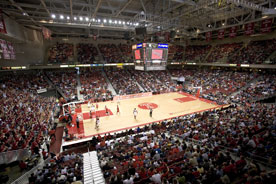
Temple University Liacouras Center
The Temple Men's basketball program is ranked 5th in all-time NCAA wins with 1,903 starting the 2017-2018 season. Only Kentucky, Kansas, North Carolina, and Duke have a higher total.
Temple is recognized as having won the first-ever National Collegiate basketball championship in 1938, under Coach James Usilton.
That Owls team, which finished with a 23–2 record, won the inaugural National Invitation Tournament by routing Colorado 60-36 in the championship final. Because the NCAA Tournament was not held until the following year, Temple's NIT championship earned the Owls the first national college basketball title. During the 1950s, the Temple basketball team made two NCAA Final Four appearances (1956, 1958) under legendary Head Coach Harry Litwack. Litwack would be inducted into the Basketball Hall of Fame after concluding a 21-year coaching career that included 373 wins.[138]
Head Coach John Chaney, who is also a Hall of Fame coach, won a total of 724 career games and took Temple to the NCAA tournament 17 times. His 1987–88 Owls team entered the NCAA tournament ranked #1 in the country, and he has reached the Elite Eight on five different occasions. He was consensus national coach of the year in 1988.[138]
On April 10, 2006, University of Pennsylvania head coach and La Salle University alumnus Fran Dunphy was named the new Temple's Men's Head Basketball coach after Chaney's retirement in conclusion of the 2006 season. Dunphy had coached the Quakers for 17 straight seasons prior to the move. Dunphy and the Owls won three straight Atlantic-10 tournaments in 2008, 2009 and 2010, with the third marking a conference-leading ninth A-10 title. In the 2011-12 season, the Owls won the A-10 regular season title.[140]
Heading into the 2015-16 season, the program owned a 116-year win-loss record of 1,849-1,024.
The Owls' history also includes 48 postseason tournament appearances (31 NCAAs, 18 NITs), two Final Four appearances (1956 and 1958) under Harry "The Chief" Litwack, five regional finals in the last 22 years under John Chaney (1988, 1991, 1993, 1999 and 2001), NIT championships in 1938 and 1969, and two Naismith Basketball Association Hall of Fame Coaches in Litwack and Chaney.
Temple is one of eight schools that have competed in the last six NCAA Tournaments, as of 2013.[141]
Alumni and faculty
There are more than 320,000 Temple alumni currently living in 50 states and 143 countries.[142]
See also
List of colleges and universities in Philadelphia